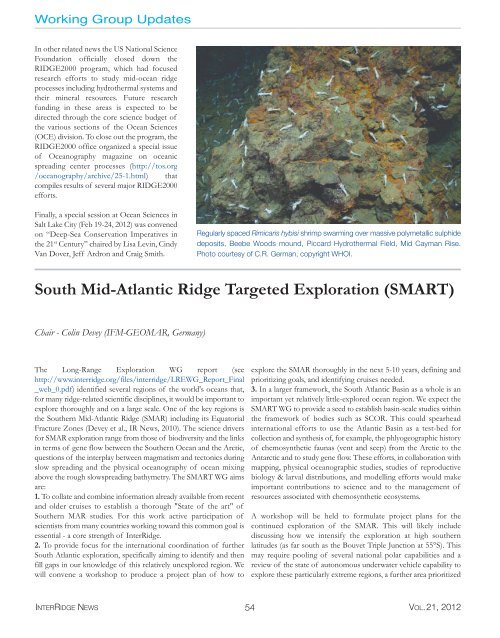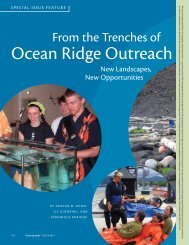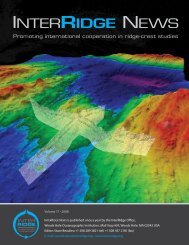Full version, low resolution, 7.5MB - InterRidge
Full version, low resolution, 7.5MB - InterRidge
Full version, low resolution, 7.5MB - InterRidge
You also want an ePaper? Increase the reach of your titles
YUMPU automatically turns print PDFs into web optimized ePapers that Google loves.
Working Group Updates<br />
In other related news the US National Science<br />
Foundation officially closed down the<br />
RIDGE2000 program, which had focused<br />
research efforts to study mid-ocean ridge<br />
processes including hydrothermal systems and<br />
their mineral resources. Future research<br />
funding in these areas is expected to be<br />
directed through the core science budget of<br />
the various sections of the Ocean Sciences<br />
(OCE) division. To close out the program, the<br />
RIDGE2000 office organized a special issue<br />
of Oceanography magazine on oceanic<br />
spreading center processes (http://tos.org<br />
/oceanography/archive/25-1.html) that<br />
compiles results of several major RIDGE2000<br />
efforts.<br />
Finally, a special session at Ocean Sciences in<br />
Salt Lake City (Feb 19-24, 2012) was convened<br />
on “Deep-Sea Conservation Imperatives in<br />
the 21 st Century” chaired by Lisa Levin, Cindy<br />
Van Dover, Jeff Ardron and Craig Smith.<br />
Regularly spaced Rimicaris hybisi shrimp swarming over massive polymetallic sulphide<br />
deposits, Beebe Woods mound, Piccard Hydrothermal Field, Mid Cayman Rise.<br />
Photo courtesy of C.R. German, copyright WHOI.<br />
South Mid-Atlantic Ridge Targeted Exploration (SMART)<br />
Chair - Colin Devey (IFM-GEOMAR, Germany)<br />
The Long-Range Exploration WG report (see<br />
http://www.interridge.org/files/interridge/LREWG_Report_Final<br />
_web_0.pdf) identified several regions of the world's oceans that,<br />
for many ridge-related scientific disciplines, it would be important to<br />
explore thoroughly and on a large scale. One of the key regions is<br />
the Southern Mid-Atlantic Ridge (SMAR) including its Equatorial<br />
Fracture Zones (Devey et al., IR News, 2010). The science drivers<br />
for SMAR exploration range from those of biodiversity and the links<br />
in terms of gene f<strong>low</strong> between the Southern Ocean and the Arctic,<br />
questions of the interplay between magmatism and tectonics during<br />
s<strong>low</strong> spreading and the physical oceanography of ocean mixing<br />
above the rough s<strong>low</strong>spreading bathymetry. The SMART WG aims<br />
are:<br />
1. To collate and combine information already available from recent<br />
and older cruises to establish a thorough "State of the art" of<br />
Southern MAR studies. For this work active participation of<br />
scientists from many countries working toward this common goal is<br />
essential - a core strength of <strong>InterRidge</strong>.<br />
2. To provide focus for the international coordination of further<br />
South Atlantic exploration, specifically aiming to identify and then<br />
fill gaps in our knowledge of this relatively unexplored region. We<br />
will convene a workshop to produce a project plan of how to<br />
explore the SMAR thoroughly in the next 5-10 years, defining and<br />
prioritizing goals, and identifying cruises needed.<br />
3. In a larger framework, the South Atlantic Basin as a whole is an<br />
important yet relatively little-explored ocean region. We expect the<br />
SMART WG to provide a seed to establish basin-scale studies within<br />
the framework of bodies such as SCOR. This could spearhead<br />
international efforts to use the Atlantic Basin as a test-bed for<br />
collection and synthesis of, for example, the phlyogeographic history<br />
of chemosynthetic faunas (vent and seep) from the Arctic to the<br />
Antarctic and to study gene f<strong>low</strong>. These efforts, in collaboration with<br />
mapping, physical oceanographic studies, studies of reproductive<br />
biology & larval distributions, and modelling efforts would make<br />
important contributions to science and to the management of<br />
resources associated with chemosynthetic ecosystems.<br />
A workshop will be held to formulate project plans for the<br />
continued exploration of the SMAR. This will likely include<br />
discussing how we intensify the exploration at high southern<br />
latitudes (as far south as the Bouvet Triple Junction at 55°S). This<br />
may require pooling of several national polar capabilities and a<br />
review of the state of autonomous underwater vehicle capability to<br />
explore these particularly extreme regions, a further area prioritized<br />
INTERRIDGE NEWS 54 VOL.21, 2012
















